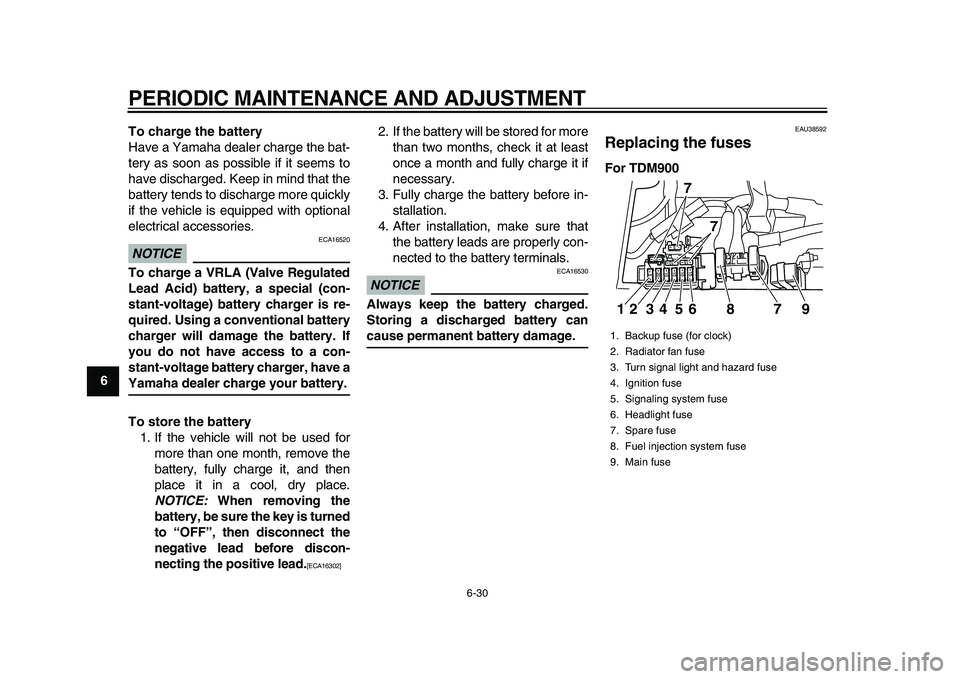Page 19 of 96
INSTRUMENT AND CONTROL FUNCTIONS
3-3
2
34
5
6
7
8
9
To lock the steering
1. Turn the handlebars all the way to
the left or right.
2. Push the key in from the “OFF” po-
sition, and then turn it to “LOCK”
while still pushing it.
3. Remove the key.To unlock the steering
Push the key into the main switch, and
then turn it to “OFF” while still pushing
it.
EAU33001
(Parking)
The steering is locked, and the taillight
and auxiliary light are on. The hazard
lights and turn signal lights can be
turned on, but all other electrical sys-
tems are off. The key can be removed.
The steering must be locked before the
key can be turned to “ ”.
NOTICE
ECA11020
Do not use the parking position foran extended length of time, other-
wise the battery may discharge.
1. Push.
2. Turn.
1. Push.
2. Turn.
✼✥✯✣✲� ✦ �
���
�
����������������
Page 23 of 96

INSTRUMENT AND CONTROL FUNCTIONS
3-7
2
34
5
6
7
8
9
This tachometer unit is equipped with a
clock.
To set the clock:
1. Push both the “SELECT” and
“RESET” buttons for at least two
seconds.
2. When the hour digits start flashing,
push the “RESET” button to set the
hours.
3. Push the “SELECT” button to
change the minutes.
4. When the minute digits start flash-
ing, push the “RESET” button to
set the minutes.
5. Push the “SELECT” button to start
the clock.
TIP
�
After setting the clock, be sure to
push the “SELECT” button before
turning the key to “OFF”, otherwise
the clock will not be set.
�
When the key is turned to “OFF”,
the clock display will remain on for
48 hours and then go off to prevent
the battery from discharging.
EAU12182
Coolant temperature gauge
With the key in the “ON” position, the
coolant temperature gauge indicates
the temperature of the coolant. When
the key is turned to “ON”, the coolant
temperature gauge needle will sweep
once across the temperature range and
then return to “C” in order to test the
electrical circuit. The coolant tempera-
ture varies with changes in the weather
and engine load. If the needle reaches
or enters the red zone, stop the vehicle
and let the engine cool. (See
page 6-36.)
NOTICE
ECA10021
Do not continue to operate the en-
gine if it is overheating.
1. Coolant temperature gauge
2. Coolant temperature gauge red zone12
✼✥✯✣✲� ✪ �
���
�
����������������
Page 76 of 96

PERIODIC MAINTENANCE AND ADJUSTMENT
6-30
1
2
3
4
5
6
7
8
9To charge the battery
Have a Yamaha dealer charge the bat-
tery as soon as possible if it seems to
have discharged. Keep in mind that the
battery tends to discharge more quickly
if the vehicle is equipped with optional
electrical accessories.
NOTICE
ECA16520
To charge a VRLA (Valve Regulated
Lead Acid) battery, a special (con-
stant-voltage) battery charger is re-
quired. Using a conventional battery
charger will damage the battery. If
you do not have access to a con-
stant-voltage battery charger, have a
Yamaha dealer charge your battery.
To store the battery
1. If the vehicle will not be used for
more than one month, remove the
battery, fully charge it, and then
place it in a cool, dry place.
NOTICE:
When removing the
battery, be sure the key is turned
to “OFF”, then disconnect the
negative lead before discon-
necting the positive lead.
[ECA16302]
2. If the battery will be stored for more
than two months, check it at least
once a month and fully charge it if
necessary.
3. Fully charge the battery before in-
stallation.
4. After installation, make sure that
the battery leads are properly con-
nected to the battery terminals.
NOTICE
ECA16530
Always keep the battery charged.
Storing a discharged battery can
cause permanent battery damage.
EAU38592
Replacing the fuses
For TDM900
1. Backup fuse (for clock)
2. Radiator fan fuse
3. Turn signal light and hazard fuse
4. Ignition fuse
5. Signaling system fuse
6. Headlight fuse
7. Spare fuse
8. Fuel injection system fuse
9. Main fuse
12 34 5 6 7 97
7
8
✼✥✯✣✲� ✦✣ �
���
�
����������������